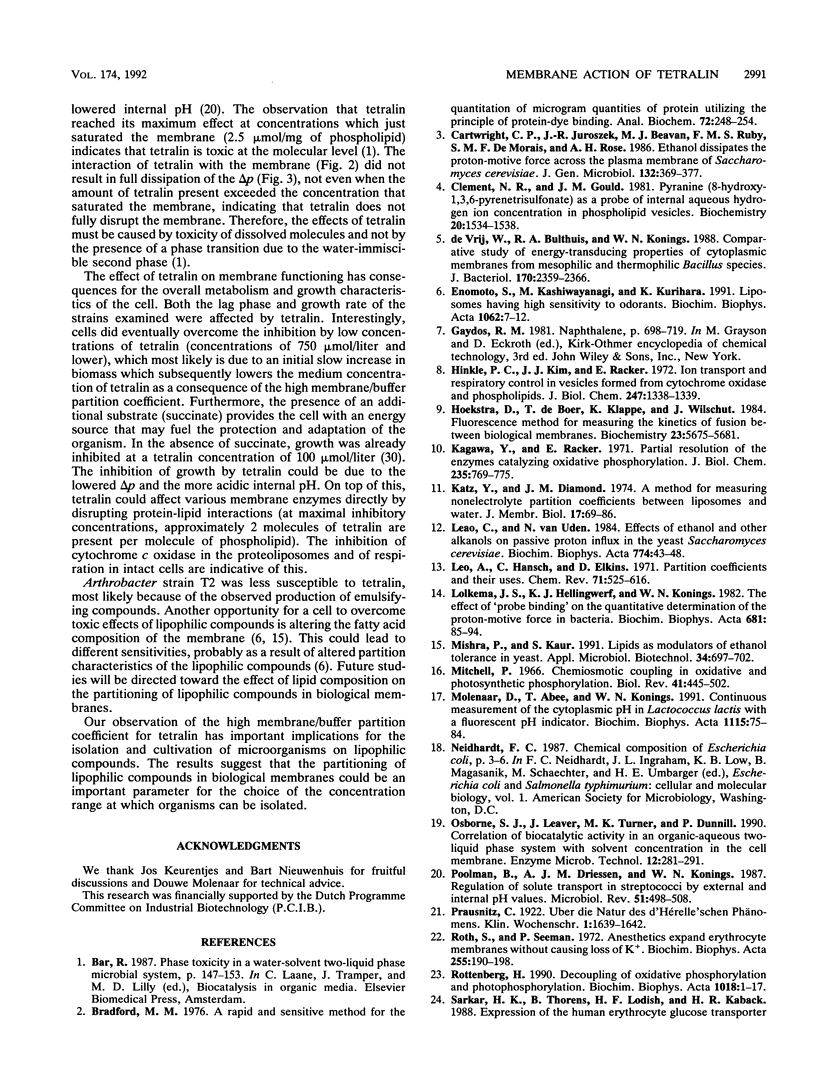Abstract
Tetralin is toxic to bacterial cells at concentrations below 100 mumol/liter. To assess the inhibitory action of tetralin on bacterial membranes, a membrane model system, consisting of proteoliposomes in which beef heart cytochrome c oxidase was reconstituted as the proton motive force-generating mechanism, and several gram-positive and gram-negative bacteria were studied. Because of its hydrophobicity, tetralin partitioned into lipid membranes preferentially (lipid/buffer partition coefficient of tetralin is approximately 1,100). The excessive accumulation of tetralin caused expansion of the membrane and impairment of different membrane functions. Studies with proteoliposomes and intact cells indicated that tetralin makes the membrane permeable for ions (protons) and inhibits the respiratory enzymes, which leads to a partial dissipation of the pH gradient and electrical potential. The effect of tetralin on the components of the proton motive force as well as disruption of protein-lipid interaction(s) could lead to impairment of various metabolic functions and to low growth rates. The data offer an explanation for the difficulty in isolating and cultivating microorganisms in media containing tetralin or other lipophilic compounds.
Full text
PDF






Selected References
These references are in PubMed. This may not be the complete list of references from this article.
- Bradford M. M. A rapid and sensitive method for the quantitation of microgram quantities of protein utilizing the principle of protein-dye binding. Anal Biochem. 1976 May 7;72:248–254. doi: 10.1006/abio.1976.9999. [DOI] [PubMed] [Google Scholar]
- Clement N. R., Gould J. M. Pyranine (8-hydroxy-1,3,6-pyrenetrisulfonate) as a probe of internal aqueous hydrogen ion concentration in phospholipid vesicles. Biochemistry. 1981 Mar 17;20(6):1534–1538. doi: 10.1021/bi00509a019. [DOI] [PubMed] [Google Scholar]
- De Vrij W., Bulthuis R. A., Konings W. N. Comparative study of energy-transducing properties of cytoplasmic membranes from mesophilic and thermophilic Bacillus species. J Bacteriol. 1988 May;170(5):2359–2366. doi: 10.1128/jb.170.5.2359-2366.1988. [DOI] [PMC free article] [PubMed] [Google Scholar]
- Enomoto S., Kashiwayanagi M., Kurihara K. Liposomes having high sensitivity to odorants. Biochim Biophys Acta. 1991 Feb 11;1062(1):7–12. doi: 10.1016/0005-2736(91)90327-5. [DOI] [PubMed] [Google Scholar]
- Hinkle P. C., Kim J. J., Racker E. Ion transport and respiratory control in vesicles formed from cytochrome oxidase and phospholipids. J Biol Chem. 1972 Feb 25;247(4):1338–1339. [PubMed] [Google Scholar]
- Hoekstra D., de Boer T., Klappe K., Wilschut J. Fluorescence method for measuring the kinetics of fusion between biological membranes. Biochemistry. 1984 Nov 20;23(24):5675–5681. doi: 10.1021/bi00319a002. [DOI] [PubMed] [Google Scholar]
- Katz Y., Diamond J. M. A method for measuring nonelectrolyte partition coefficients between liposomes and water. J Membr Biol. 1974;17(1):69–86. doi: 10.1007/BF01870173. [DOI] [PubMed] [Google Scholar]
- Leão C., Van Uden N. Effects of ethanol and other alkanols on passive proton influx in the yeast Saccharomyces cerevisiae. Biochim Biophys Acta. 1984 Jul 11;774(1):43–48. doi: 10.1016/0005-2736(84)90272-4. [DOI] [PubMed] [Google Scholar]
- Mitchell P. Chemiosmotic coupling in oxidative and photosynthetic phosphorylation. Biol Rev Camb Philos Soc. 1966 Aug;41(3):445–502. doi: 10.1111/j.1469-185x.1966.tb01501.x. [DOI] [PubMed] [Google Scholar]
- Molenaar D., Abee T., Konings W. N. Continuous measurement of the cytoplasmic pH in Lactococcus lactis with a fluorescent pH indicator. Biochim Biophys Acta. 1991 Nov 14;1115(1):75–83. doi: 10.1016/0304-4165(91)90014-8. [DOI] [PubMed] [Google Scholar]
- Osborne S. J., Leaver J., Turner M. K., Dunnill P. Correlation of biocatalytic activity in an organic-aqueous two-liquid phase system with solvent concentration in the cell membrane. Enzyme Microb Technol. 1990 Apr;12(4):281–291. doi: 10.1016/0141-0229(90)90100-5. [DOI] [PubMed] [Google Scholar]
- Poolman B., Driessen A. J., Konings W. N. Regulation of solute transport in streptococci by external and internal pH values. Microbiol Rev. 1987 Dec;51(4):498–508. doi: 10.1128/mr.51.4.498-508.1987. [DOI] [PMC free article] [PubMed] [Google Scholar]
- Roth S., Seeman P. Anesthetics expand erythrocyte membranes without causing loss of K + . Biochim Biophys Acta. 1972 Jan 17;255(1):190–198. doi: 10.1016/0005-2736(72)90021-1. [DOI] [PubMed] [Google Scholar]
- Rottenberg H. Decoupling of oxidative phosphorylation and photophosphorylation. Biochim Biophys Acta. 1990 Jul 17;1018(1):1–17. doi: 10.1016/0005-2728(90)90103-b. [DOI] [PubMed] [Google Scholar]
- Schraa G., Bethe B. M., van Neerven A. R., Van den Tweel W. J., Van der Wende E., Zehnder A. J. Degradation 1,2-dimethylbenzene by Corynebacterium strain C125. Antonie Van Leeuwenhoek. 1987;53(3):159–170. doi: 10.1007/BF00393844. [DOI] [PubMed] [Google Scholar]
- Seeman P., Kwant W. O., Sauks T., Argent W. Membrane expansion of intact erythrocytes by anesthetics. Biochim Biophys Acta. 1969;183(3):490–498. doi: 10.1016/0005-2736(69)90163-1. [DOI] [PubMed] [Google Scholar]
- Seeman P., Roth S., Schneider H. The membrane concentrations of alcohol anesthetics. Biochim Biophys Acta. 1971 Feb 2;225(2):171–184. doi: 10.1016/0005-2736(71)90210-0. [DOI] [PubMed] [Google Scholar]
- Seeman P. The membrane actions of anesthetics and tranquilizers. Pharmacol Rev. 1972 Dec;24(4):583–655. [PubMed] [Google Scholar]
- Uribe S., Ramirez J., Peña A. Effects of beta-pinene on yeast membrane functions. J Bacteriol. 1985 Mar;161(3):1195–1200. doi: 10.1128/jb.161.3.1195-1200.1985. [DOI] [PMC free article] [PubMed] [Google Scholar]
- Uribe S., Rangel P., Espínola G., Aguirre G. Effects of cyclohexane, an industrial solvent, on the yeast Saccharomyces cerevisiae and on isolated yeast mitochondria. Appl Environ Microbiol. 1990 Jul;56(7):2114–2119. doi: 10.1128/aem.56.7.2114-2119.1990. [DOI] [PMC free article] [PubMed] [Google Scholar]


